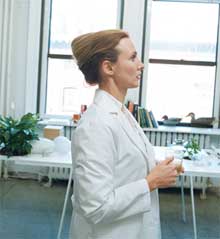
My notes from Natalie Jeremijenko‘s talk at the New Cultural Networks conference, a one day event organized in Amsterdam by the Sandberg Institute.
Natalie decided to work in new media and techno art because the field promised new worlds, new relationships and looked like a place where social and cultural changes were possible.
Developments in technology are mostly done by the military and big corporations, they work for they own interests and what comes out of their R&D labs has unintended consequences and provides artists with opportunities to create social changes.
She showed one of her previous works which engaged with structures of participation. The project was installed in a “white box” type museum. Traditionally, explanatory texts are hanging or printed on the wall. People stand side by side to read it but never talk to each other. Most museums now have at least one audio tour. Visitors are then immersed in their own private audio space and won’t talk to each other either because they simply wouldn’t be able to hear each other. Her intervention was a sound installation which broadcasts the message. The sound seemed to pierce through the silence of the gallery but it also temporarily synchronized visitors, giving them more opportunities for exchange, local participation, interaction.
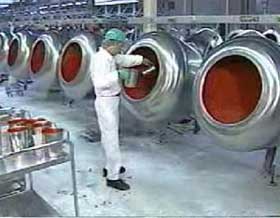 HSM: The drums spin the jelly beans as workers pour in freshly made flavored and colored syrups onto the centers
HSM: The drums spin the jelly beans as workers pour in freshly made flavored and colored syrups onto the centers
How Stuff Is Made is an online visual encyclopedia started 4 years ago. It visually documents every process in the production of goods. If you wanted to transform the industry into something more sustainable which strategy would you prefer? Would your method be characterized by secrecy and non disclosure agreements? Or would you rather promote openness and communicate where are the new ideas, the good materials? If you think of what you possess and what you wear, how much can you really account for? Do you know anything about the labor conditions? Or how these products recycle once they are dumped? We are supposed to live right into the information age, we often complain of being flooded with too much information, yet we know very little when it comes to toxic activities.
For the How Stuff Is Made visual essays, each students have to make their way inside manufactories and discuss with workers, employees, designers, etc. The students document every processes, labor conditions and environmental impacts involved in the production of the good. Afterwards they list a series of suggestions to improve the manufacturing process. Making some discoveries along the way: such as Chinese workers receiving 45 cents per hour to make the American flag or Chinese fortune cookie made mostly in Chicago by Hispanics. One of the project’s aims is to redirect manufacturing practices and consumer purchasing decisions toward a transparent and legible information base.
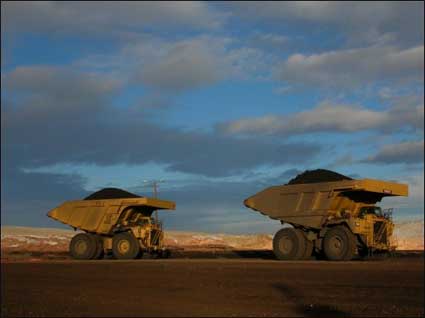 Haul Trucks. Reminiscent of giant beetles, haul trucks wait in line to deliver their coal loads
Haul Trucks. Reminiscent of giant beetles, haul trucks wait in line to deliver their coal loads
Every students who did their assignment felt more responsible after that. They also discovered that reality is much more complex than the idea that there are just bad corporations manipulating poor innocent consumers.
Feral Robotic Dogs was inspired by the craze for interactive toys.What are robotics dogs for? What do you have to learn with interactive toys? To be interactive? We don’t need them to learn how to interact.
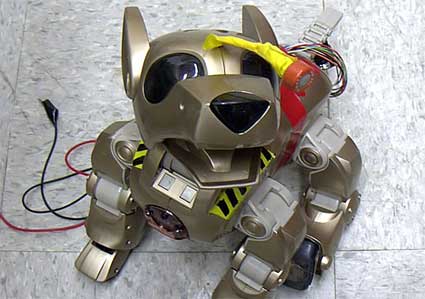
The FRD are dogs rescued from the dumps where the abandoned robotic dogs end up. They get an upgrade: a brain surgery, a new nose and some robust legs or wheels to go everywhere.
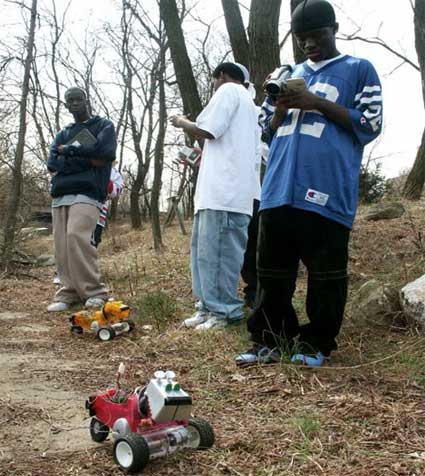
Bronx: old tanks underneath the park. When you release a pack of FRD on a contaminated space, they sniff the area for traces of contamination. The media show up immediately and of course if they talk about the robot dogs they have to mention the existence of the contamination, they interview the students, etc.
Natalie showed a map of Silicon Valley which is the area with most Superfund Sites.
Ooz is zoo backwards and without cage.
We are facing a new phenomenon of urban migration. It used to be the poor from rural areas who migrated to the city in search of work in the industry. Nowadays, the animals “formally known as wild” are migrating to our cities. So it might be time to rethink our relationship with the natural system.
Several remote-controlled robotic geese let loose in various urban areas. The robotic goose interacts with the local goose population. The interface allows people to follow the birds closely and interact in ways that would not otherwise be possible. The goose drivers (or “gooser”) can ‘talk to’ the geese through the interface, delivering prerecorded goose ‘words,’ their own vocal impersonations, or other sounds (such as goose flute hunting calls). Each utterance via the robotic goose triggers the camera in the robot’s head to capture 2-4 seconds of video recording the responses of the animal. These video samples upload to the goosespeak database that the participants can annotate.
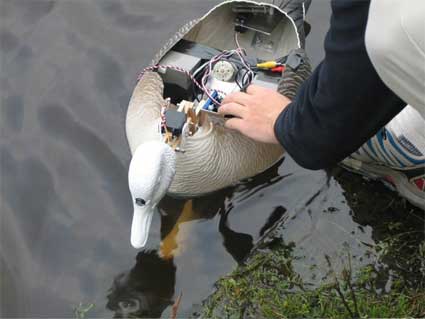
Left to their own devices, the robotic geese repeat what another (real) goose has done a few moments before. It’s like a big gameboy, except that the platform is your local park.
Natalie freed her robotic gooose in the ECO Park of Los Angeles. Kids came running, they wanted to play with the robotic goose too and realized in the process that they had never noticed the existence of the geese before. By tiptoeing around to see the habitat of the geese, the children saw broken shells. They did their research and discovered that if the shell was broken it was because the pesticides and fertilizers used in the park were bad for the eggs. By playing they had discovered the complexity of ecological connections. That’s another difference with Gameboy, here the game is open-ended not crypted.
Together with Debra Solomon, Natalie cooked a Dinner for Geese and People with food delicious for both the goose and the humans. Natalie and Debra are working on an interspecies cookbook and are still in search of a publisher for it.
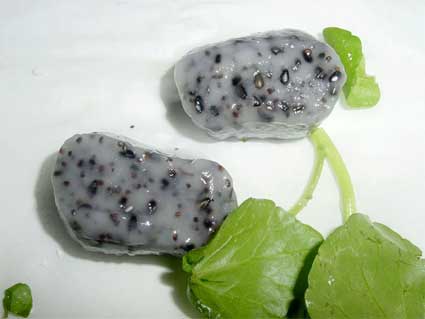 Pasta di Larvae (image Debra Solomon)
Pasta di Larvae (image Debra Solomon)
She also designed bird operable technology. For the Whitney Biennale, the artist installed public twoilets (toilets for pigeons), the guano was collected and used for soil fertilization. She also developed perches allowing birds to communicate with humans. When the birds land on the perch they trigger a sound file that translate birds concerns into the human dialect. The messages range from “Buy some health bar (you call it bird food) and scatter it around. That’s a good person!” to “It’s in your interest that i am happy and healthy. Bird flu so please share your lunch with me and do not monopolize the nutritious resources.”
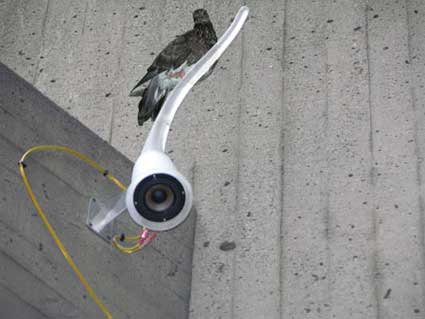
Ooz for the Fish communication: Fishface Sensor Array. When a fish swims underneath the buoy, the light is turned on to tell humans that the fish is in that area at that particular moment and that they can throw it some food. The same goes for the fish who knows that it is the signal: food is likely to appear.
In zoo, you’ll see almost everywhere notices that say “Do not feed the animals”. Why not? What we eat is good enough for us but not for them? Why can’t we interact with the animals? Whether we like it or not we keep interacting with them and interfering with their life and habitat.
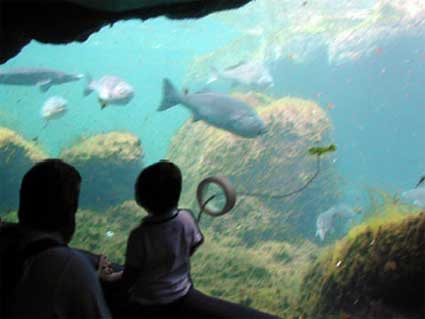 Fish Restaurant interaction window
Fish Restaurant interaction window
Fish restaurant where you feed the fish instead of eating fish.
New laboratory.
What if we are in the middle of a climate crisis? How can we react to global warming? What can we learn from our experience with participative media?

We all know about global warming. Consuming less gas, closing the water tap while brushing our teeth, writing to politicians, etc. doesn’t make us feel useful enough. It makes us feel impatient. But that doesn’t mean that we cannot make progress. We need high standards of evidence: What works where, how and with whom? We need to concentrate our effort on our local environment.
That’s how Natalie came up with her new project: a health clinic not for patients but for the environment. Impatient people would come with their environmental concerns and get our with prescriptions and advice. Prescriptions for action and referrals to relevant art, design, participatory projects, local environmental organizations, etc.
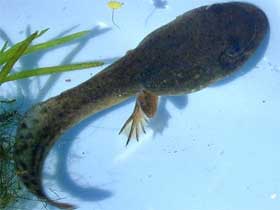
The records of the visits and treatments would be like Facebook, they are external and shared. You can log on and create your own impatient page.
You could be prescribed a tadpole. You get one, raise it and set up a social network page for it where you can upload videos of it. Tadpole are so sensitive that we can regard them as experts in environmental pollution. PCB level in women’s breast milk is the same as in the Hudson River.
The age of puberty of US girls has fallen of 3 years. A tadpole could detect the quality of the water.
Other examples of prescriptions:
Mouse live in our houses and share our diet. One of the prescriptions is a mouse trap to take blood samples from the mouse. When the animal is in the trap, the trap sends a text message on your cell phone so you can rush there, take a blood sample, have it analyzed and check if there is anything suspect in your body.
Energy return system in shoes, a spring installed in the heel of the show “returns a spring to your steps.”
2 specially-developed prescription products:
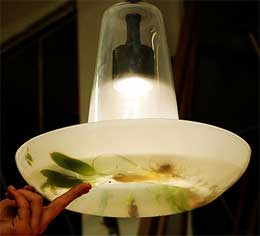 Greenlight (x design) addresses indoor air quality.
Greenlight (x design) addresses indoor air quality.
The solar-powered lighting product diffuses light by coupling to photosynthetic processes. Planting strategies can be specified to address particular indoor air quality issues including VOC, benzene and formaldehyde removal.
Like other prescription products this product requires a clinic appointment to introduce the design parameters involved, and the novel issues involved in distributed power production.
The second one: If we are in a climate crisis what you need is a spacestation.
Portrait of Natalie Jeremijenko by Trujillo-Paumier for GOOD magazine.
Previously: OOZ, Inc. (…for the birds), Reverse Engineers.
